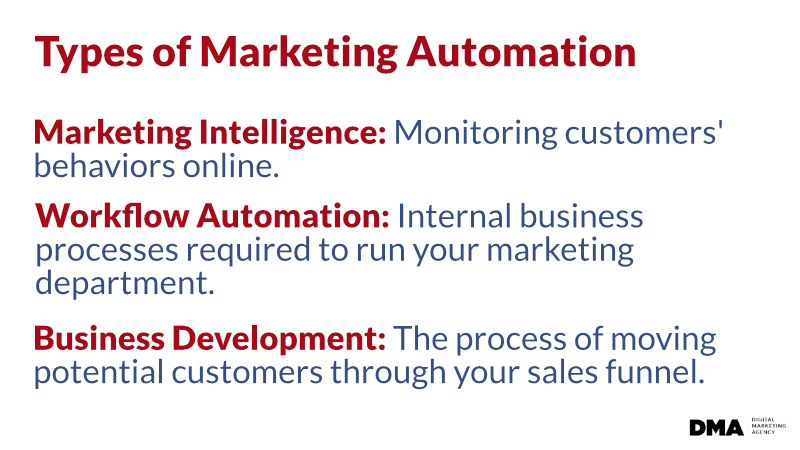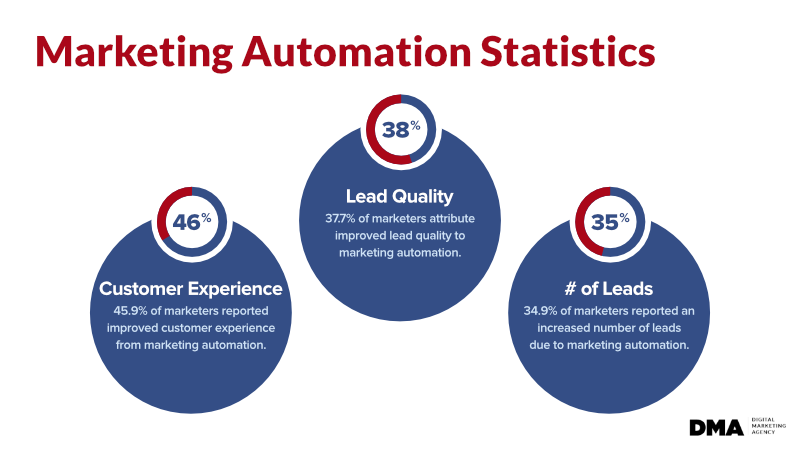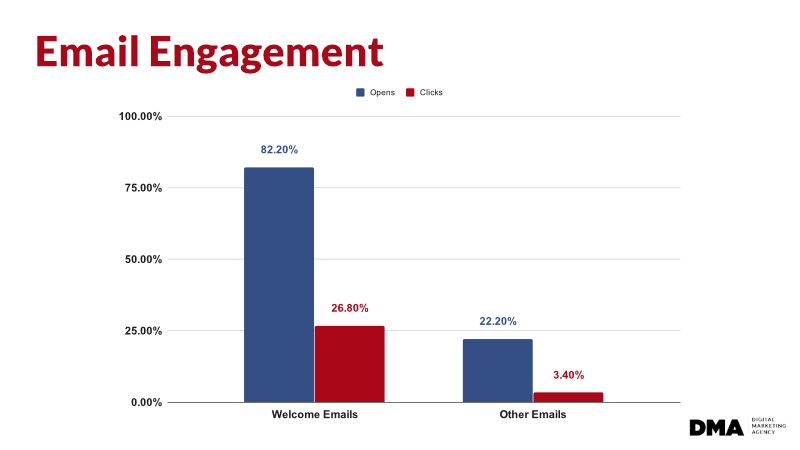SEO
Free SEO Analysis
SEO Services
Content Marketing Services
Local SEO
Link Building Services
Specialized SEO Services
PPC
REPUTATION MANAGEMENT
Free Reputation Management Analysis
Reputation Management Services
Review Management Services
Specialized Reputation Management Services
CEO Reputation Management
Brand Enhancement
Business and Directory Listings
Comprehensive Reputation Management Audit
SOCIAL MEDIA
Free Social Media Analysis
Specialized Social Services
WEB DEVELOPMENT
Free Website Analysis
Web Design Services
Mobile Development Services
Website Maintenance Services
Specialized Development Services
MARKETING AUTOMATION
Free Marketing Automation Analysis
Specialized Marketing Automation Services
Comprehensive Marketing Automation
INDUSTRIES
ABOUT DMA
Marketing Automation
What Is Marketing Automation (Plus, How to Use it to Supercharge Your Marketing)
Request a quote
Its Fast, Easy & Free
Executive Summary
- Automating repetitive marketing tasks gives your team more time to spend on bigger tasks like customer journey mapping, workflow, and marketing strategy.
- Nucleus Research found that marketing automation increases productivity by 20% on average.
- Automating your marketing workflows is just the start of an ongoing process of implementing, reviewing, analyzing, and adjusting your marketing efforts.
Marketing automation can help marketers better understand the customer journey, automotive repetitive, marketing tasks, generate qualified leads, nurture them, and convert them into paying customers.
But if you’re not already using marketing automation, you might not be sure how to get started. In this article, we’ll share the basics of marketing automation as well as nine marketing automation best practices.
Let’s start with a quick definition of marketing automation.
What Is Marketing Automation?
Marketing automation is the act of using tools and software to automate recurring and repetitive marketing tasks. This includes tracking and measuring performance, keeping the number of manual actions down and more effective, and ultimately, improving productivity.
Automating repetitive marketing tasks gives your team more time to spend on bigger, needle-moving tasks like customer journey mapping, workflow, and marketing strategy.
According to the 2019 State of Marketing Automation Survey Report, 75% of marketers say they use at least one type of marketing automation tool.
Not only that but in the 2019 House of Marketing report, marketing automation is one of the four most popular ways 48% of marketers report creating a personalized customer experience.
That’s great to hear since many people believe that marketing automation means less personalized customer experiences.
Three Types of Marketing Automation
There are three basic types of marketing automation, and we’ll take a closer look at each of them.

Marketing Intelligence
Marketing intelligence involves monitoring customers’ behaviors online. It’s marketing reconnaissance, giving marketing details that are important to understanding the people they’re trying to reach.
You can use various tracking tools to monitor customer behavior, then analyze that behavior to find patterns that you use to create market segments based on behavior.
Whenever you sign up for a discount card at your local grocery store, you’re participating in their marketing intelligence program.
This makes it easier for them to offer you deals that they know you’re likely to take advantage of due to your past purchasing behavior.
Workflow Automation
Workflow automation is your internal business processes required to run your marketing department. This could be your marketing calendar, digital asset management, budgeting, or any number of things.
More and more, workflow automation technology has become more accessible to smaller businesses.
Business Development
Business development focuses on the process of moving potential customers through your sales funnel. You do this through segmentation and nurturing, reaching out to leads through email, social media, and SEO content.
Of course, this requires that you have a way to identify qualified leads and have a lead nurturing strategy in place.
Benefits of Marketing Automation

According to a survey by Liana Technologies, marketing automation results in improved customer experience (45.9%), improved quality of leads (37.7%), and an increased number of leads (34.9%) for those surveyed.
In addition, Nucleus Research found that marketing automation also increases productivity by 20% on average.
So, for those keeping score, marketing automation can:
Improve customer experience
Improve lead quality
Increase the number of leads
Boost productivity
Plus, Protocol80 found that automated lead nurturing contributed 15–20% of conversions to sales.
The benefits of marketing automation can be felt at multiple steps along your sales funnel and can increase your conversions greatly.
There are four key ways marketing automation achieves these benefits for your business.
Automate Your Marketing Activity
Marketing automation helps you automate tasks and workflows throughout the sales cycle. This could be anything from sending emails to forwarding leads to your sales team.
Marketing automation gives you an easy way to nurture leads from collection to conversion.
Nurture Leads Across Channels
A very basic sales funnel can be broken down into three stages:
Awareness
Consideration
Decision
Each of those stages has its own associated marketing strategies and even content and marketing channels that work best to nurture leads and send them further along the funnel.
Marketing automation makes it a lot easier to reach leads no matter where there are in the sales cycle. It also makes it easier to move those leads through the customer journey.
Identify Bottlenecks in Your Sales Funnel
As leads move through your sales funnel, it’s common to lose some of them along the way. It’s a funnel, after all, and gets smaller the closer things get to conversion.
Not everyone who enters your sales funnel is going to buy your product. And that’s okay.
What’s not okay is leads dropping out of your sales cycle due to a breakdown or bottleneck in your sales funnel.
Marketing automation can help you quickly identify places of friction where you’re losing more leads from your sales cycle than you should be.
Since many marketing automation platforms include lead scoring, you’ll have more than just an idea of how many conversions you can expect. And, you’ll be able to look at your reports to find out where leads are leaving.
Reduce Marketing Costs
With a complete marketing automation platform, you’ll be able to reduce the number of resources you need to manage all the various marketing tasks required.
Not only will that reduce your costs directly, but it will also reduce costs indirectly because you’re not spending time and money learning and maintaining multiple marketing tools.
Marketing Automation Best Practices
Marketing automation doesn’t exist apart from your normal marketing processes. Instead, it’s an effective tool you can use to help you achieve your marketing goals.
As always, the goal of marketing is to get new leads, move leads through your sales funnel, convert leads to customers, then convert customers to advocates.
Marketing automation should support your marketing goals, not operate separately from them.
Now, let’s take a look at nine marketing automation best practices that will help you incorporate marketing automation into your marketing strategy.
1. Set Clear Goals
Without a goal, how do you know where you want to go or when you’ve gotten there?
After you’ve set your overall marketing goals, consider the benefits of marketing automation, and how you can improve your marketing efforts. Then, set marketing automation goals around that.
This could look like tracking a specific number of qualified leads, sending a certain number of leads onto your sales team, or increasing the number of conversions.
2. Send a Welcome Email Series
One of the best ways to nurture leads is to send a welcome email series to new subscribers or new customers.
Welcome emails get tons of engagement. According to GetResponse, welcome emails get nearly four times the number of opens and seven times the number of clicks compared to other emails.

3. Automate List Segmentation
Segmentation is simply dividing leads and customers into groups with similar characteristics.
There are virtually limitless ways to segment your list:
Purchase behavior
Industry
Profession
Location
Demographics
Interests
...and more
Segmenting your contact or email list makes it easy to create personalized emails and automate them.
4. Clean Your Contact List Regularly
Did you know that email lists naturally degrade by about 25% every year? When you consider that most email marketing service providers (ESPs) charge you based on the size of your list, it’s clear that maintaining a clean list is important—both for your expenses and list quality.
When you clean your list regularly, you’ll be able to focus on high-quality leads that are interested in engaging with you.
Check with your ESP to find out if it has a built-in list cleanup tool. If not, never fear. Cleaning your list doesn’t have to be hard.
First, get rid of the folks who have unsubscribed. It’s possible that they’re engaging with your company in another way, but if they’ve unsubscribed to your marketing emails, give them a few months to see if they’re engaging in other ways and if not, get rid of them.
Next, get rid of anyone in your list with a fake email address. Some ESPs have email verification tools that you can use. You can use a bulk email verifier to find the fakes.
Finally, find and merge duplicates.
5. Base Workflows on the Customer Journey
Use your customer journey to map out your marketing workflows. You’ll need to do this for each of your buyer personas since each of them are different.
Be sure to map workflows for each stage of the customer journey:
Awareness: When a lead knows of their pain point and is trying to find a solution.
Consideration: Leads know that your company is one of the solutions to their pain point and are trying to decide between you and another company (or doing nothing).
Decision: Leads make a decision and purchase.
After the Purchase: Customers come to you with questions about your product or service or need additional resources.
When you map out workflows based on your customer journey, you’ll know who you’re targeting and when. This will help you send targeted marketing messages that hit their target.
6. Create Engaging Content
Each stage of your sales funnel will involve specific types of content that work best for leads in that stage.
Awareness: Ads, landing pages, videos, infographics, checklists
Consideration & Decision: Blog posts (how-tos or guides), social media, white papers and ebooks, case studies, webinars, rations and reviews, email
Post-Purchase: Surveys, special offers, contests and giveaways, emails, social media
Most importantly, your content must be relevant. This means providing content that your audience is interested in.
The purpose of your content is to grab the attention of your target audience and keep it. You can do this in a number of ways, but your content should always offer something of value.
7. Use Automated Event Triggers
One of the best ways to provide the right content to your leads that meets their needs where they are is by setting up automated trigger actions.
For instance, you can set up triggers based on factors like where the lead works, their industry, demographics, stage of the sales funnel they’re in, and more.
This is why sending a welcome email series works.
When someone new signs up for your newsletter or buys your product, they’re expecting to hear from you. In the case of a new subscriber, they’re likely interested in learning more about your company, what you have to offer, and how you can help them, so the content you’d send them will focus on that.
For a new customer, they’re more interested in how to make their experience with you and your products the best it can be. For a new customer, you might send instructional material that helps them get the most out of the product they just bought.
8. Engage in Social Listening
Social media marketing is vital to your marketing strategy. But it can be a lot to monitor, especially when you have other things going on (like running your business).
Leads see social media as more personal than a typical marketing email. And, good news, your social media efforts can be automated.
Social customer relationship management is an advanced marketing automation tactic, but many marketing automation platforms offer alerts for social media events. This means that you can respond quickly for lead generation and nurturing.
If you’re not sure how to get started with social media, consider hiring a digital marketing agency to handle it for you. Digital Marketing Agency offers social media marketing services and can help you build long-term relationships through social.
9. Monitor and Evaluate Your Performance
To understand the value of your marketing automation efforts, you’ll need to monitor and evaluate your performance. This is where those goals come back into play.
How many qualified leads did you generate? How many leads did you forward to your sales team? How many conversions did you get?
Automating your marketing workflows is just the start of an ongoing process of implementing, reviewing, analyzing, and adjusting your marketing efforts.
Take the time to review your goals against your performance and revise your approach as needed.
How to Get Started With Marketing Automation
Marketing automation can help you stop missing out on opportunities. To get started with marketing automation the right way, contact Digital Marketing Agency for a free marketing automation analysis.
Our Sales team